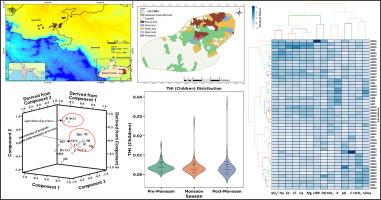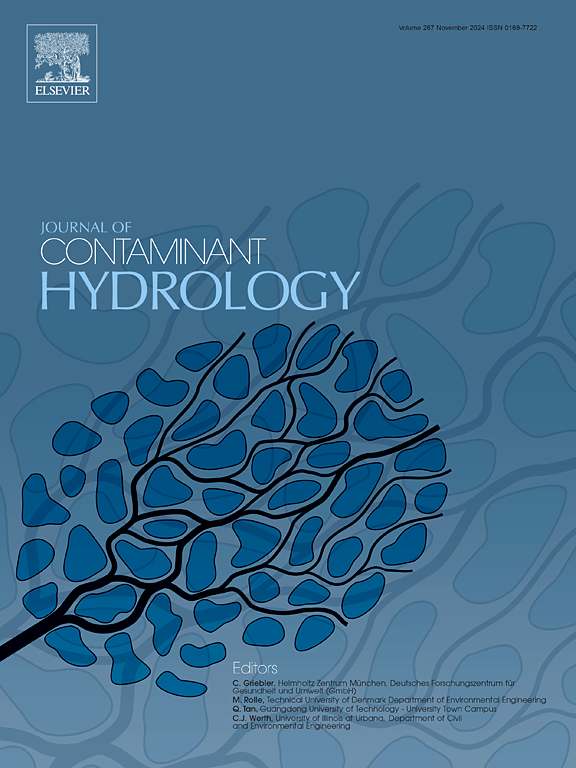冈瓦纳矿床地下环境的风化作用由于采矿和农业活动的累积影响而加剧
IF 4.4
3区 环境科学与生态学
Q2 ENVIRONMENTAL SCIENCES
引用次数: 0
摘要
我们提出了一个整体框架来评估印度受采矿影响地区的地下水污染及其相关的健康风险,重点是确定驱动地下水化学的关键过程,量化污染物水平,并评估健康风险。结果表明,季风前至季风后的季节变化,以及地质和人为因素的混合作用,驱动了复杂的水化学机制。从季风前到季风后,从碳酸盐风化到硅酸盐风化逐渐变化,而农业活动引起的人为输入导致地下水受到NO3−等阴离子的污染。发现高F -水平受pH水平的影响,导致矿区含F矿物的解吸释放或溶解。健康风险评估表明,儿童是最脆弱的。虽然农业投入对地下水质量的影响比采矿活动更明显,但季风驱动的稀释改变了所有质量参数的聚类模式,表明主动补给和混合。这项研究审查了硬岩含水层中发生的风化作用增强的过程,其特点是补给率很高,而采矿作业和农业做法的累积影响对这一过程产生了不利影响。未来的研究应侧重于实施长期监测计划,以在全球类似的环境中保护水资源和公众健康。本文章由计算机程序翻译,如有差异,请以英文原文为准。

Weathering in the subsurface environment of the Gondwana deposits intensified by the cumulative impacts of mining and agriculture practices
We present a holistic framework to evaluate groundwater contamination and its associated health risks in a mining-affected region of India with a focus on identifying key processes driving groundwater chemistry, quantifying contaminant levels, and assessing the health risks. Results revealed a complex hydrochemical regime driven by seasonal changes from pre- to post-monsoon and the intermixing of both geogenic and anthropogenic factors. A gradual change from carbonate weathering to silicate weathering from pre- to post-monsoon was observed, while anthropogenic inputs due to agricultural activities resulted in the contamination of groundwater by anions like NO3−. High F− levels were found to be impacted by pH levels resulting in either the desorptive release or dissolution of F−-bearing minerals in the mining areas. Health risk assessments showed that children were the most vulnerable. Although the imprints of agricultural inputs were more explicit on the groundwater quality than that of mining activities, the monsoon-driven dilution shifts clustering patterns of all quality parameters, indicating active recharge and mixing. The study presented an examination of enhanced weathering processes occurring in hard-rock aquifers characterized by substantial recharge rates, which are adversely affected by the cumulative influence of mining operations and agricultural practices. Future research should focus on implementing long-term monitoring programs to safeguard water resources and public health in similar settings globally.
求助全文
通过发布文献求助,成功后即可免费获取论文全文。
去求助
来源期刊

Journal of contaminant hydrology
环境科学-地球科学综合
CiteScore
6.80
自引率
2.80%
发文量
129
审稿时长
68 days
期刊介绍:
The Journal of Contaminant Hydrology is an international journal publishing scientific articles pertaining to the contamination of subsurface water resources. Emphasis is placed on investigations of the physical, chemical, and biological processes influencing the behavior and fate of organic and inorganic contaminants in the unsaturated (vadose) and saturated (groundwater) zones, as well as at groundwater-surface water interfaces. The ecological impacts of contaminants transported both from and to aquifers are of interest. Articles on contamination of surface water only, without a link to groundwater, are out of the scope. Broad latitude is allowed in identifying contaminants of interest, and include legacy and emerging pollutants, nutrients, nanoparticles, pathogenic microorganisms (e.g., bacteria, viruses, protozoa), microplastics, and various constituents associated with energy production (e.g., methane, carbon dioxide, hydrogen sulfide).
The journal''s scope embraces a wide range of topics including: experimental investigations of contaminant sorption, diffusion, transformation, volatilization and transport in the surface and subsurface; characterization of soil and aquifer properties only as they influence contaminant behavior; development and testing of mathematical models of contaminant behaviour; innovative techniques for restoration of contaminated sites; development of new tools or techniques for monitoring the extent of soil and groundwater contamination; transformation of contaminants in the hyporheic zone; effects of contaminants traversing the hyporheic zone on surface water and groundwater ecosystems; subsurface carbon sequestration and/or turnover; and migration of fluids associated with energy production into groundwater.
 求助内容:
求助内容: 应助结果提醒方式:
应助结果提醒方式:


